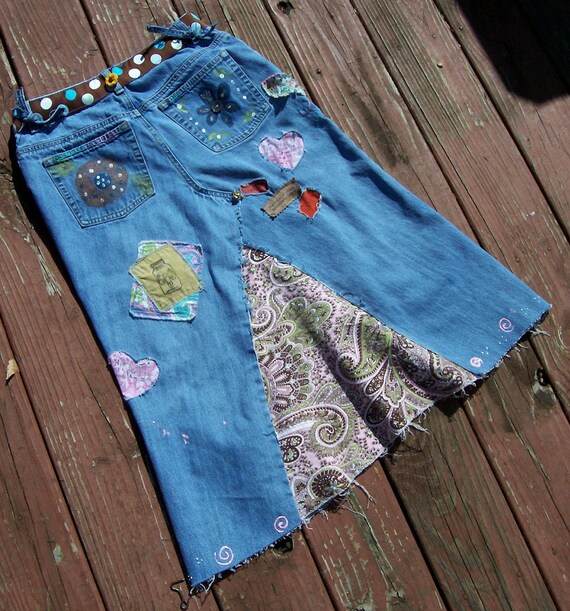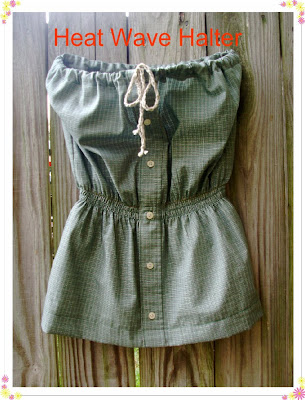Everything old is new again: working with recycled materials
I vividly remember the day my creative life changed...
Nine years ago, my husband signed me up to be a participant in a class at a local quilting shop. The day's topic: creating a skirt from a pair of old, unwanted jeans. I was intrigued. Having just started sewing not long before that, it never occurred to me that an aspiring maker could create using anything other than the fabric and materials sold in cloth and craft stores. The instructions for the class simply said to bring a pair of jeans that fit, your sewing machine, and any trims, embellishments and fun things you might want to add to your skirt. So I packed up my machine, threw a pair of jeans and a few pieces of ribbon into a bag, and prepared to spend the better part of my (childless) Friday at my class, not knowing how much the entire experience would alter my life beyond that of being a seamstress.
The first order of business in the class: cut into my jeans to separate the legs. I had never put a hole in a piece of clothing on purpose; sure, I had cut old jeans into cutoff shorts, but that was because the jeans were old and had holes in the knees, so that seemed justified. Now I'd be cutting into a pair of pants that were perfectly fine. At the time, I was a stay-at-home mom with two small kids and no income (hence the importance of this celebrated Mom's-Day-Out Friday), so I wasn't really thinking about damaging a pair of fine jeans that it would cost money - money we didn't really have - to replace. Still, without any hesitation, I got out my scissors and cut out the inseam of the jeans.
And that's when it all began. I was hooked.
With nothing but exhilaration, I spent the next several hours cutting, sewing, altering and drawing until I had a gorgeous, personalized skirt:



Nine years ago, my husband signed me up to be a participant in a class at a local quilting shop. The day's topic: creating a skirt from a pair of old, unwanted jeans. I was intrigued. Having just started sewing not long before that, it never occurred to me that an aspiring maker could create using anything other than the fabric and materials sold in cloth and craft stores. The instructions for the class simply said to bring a pair of jeans that fit, your sewing machine, and any trims, embellishments and fun things you might want to add to your skirt. So I packed up my machine, threw a pair of jeans and a few pieces of ribbon into a bag, and prepared to spend the better part of my (childless) Friday at my class, not knowing how much the entire experience would alter my life beyond that of being a seamstress.
The first order of business in the class: cut into my jeans to separate the legs. I had never put a hole in a piece of clothing on purpose; sure, I had cut old jeans into cutoff shorts, but that was because the jeans were old and had holes in the knees, so that seemed justified. Now I'd be cutting into a pair of pants that were perfectly fine. At the time, I was a stay-at-home mom with two small kids and no income (hence the importance of this celebrated Mom's-Day-Out Friday), so I wasn't really thinking about damaging a pair of fine jeans that it would cost money - money we didn't really have - to replace. Still, without any hesitation, I got out my scissors and cut out the inseam of the jeans.
And that's when it all began. I was hooked.
With nothing but exhilaration, I spent the next several hours cutting, sewing, altering and drawing until I had a gorgeous, personalized skirt:


It was perfectly shabby, unfinished, and sentimental, with pieces of my life and my personality all over it.

Energized, I could not wait to go home and cut up EVERYTHING I could find to further my reclaimed-materials habit. And then it occurred to me:
I have a Goodwill up the street.
Hold the phones. That place would be, and is, a never-ending treasure trove of reclaimed and recycled materials if I ever ran out of things from my own closet. While I had long been a fan of thrift stores, having had no choice but to get most of my clothes from them while growing up, it never occurred to me that I didn't have to wear the clothes in the store as is, from the rack. Now, armed with imagination and a relatively inexpensive sewing machine, I could make them into whatever I wanted. Pillowcases could become shopping bags. Men's shirts could become dresses for my 2-year-old daughter. T-shirts could become literally hundreds of different things, from headbands to bags to underwear (yes, underwear). My "fabric" hoard started. And grew.
A few years later in a different thrift store, I stumbled upon BAGS of new, uncut fabric waiting to come home with me. I thought I'd won the lottery. In those bags, I usually find yards and yards of pristine fabric yardage, and I always wonder how it got there. Did a long-time quilter pass away and her family gave away her fabric stash? Did a seamstress decide to downsize and get rid of some of her supplies? I never know, but I love thinking about it, and I love working with materials that have a history behind them.
In those bags, I often find fabric that is brand new, still with labels on it, like this:
that I can wash, press, and turn into this
 |
| Disco Dots headband, available in my Etsy shop. |
The reasons I sew with recycled (upcycled? repurposed? renewed? I have struggled with the phrasing for years) fabric are multiple. Knowing that I didn't pay $7.99 or more a yard - the price of most new, off-the-bolt fabric - allows me to buy more, for one. This is great for our family budget and allows me to keep prices in my Etsy shop lower because the cost of my materials is lower. There is also a freedom that comes from knowing that my materials were relatively inexpensive, so I don't feel intimidated to make a perfect project the first time around, because I can just try again. The environmental benefits are obvious, since the manufacturing process involved in creating new fabrics can leave a large footprint on several of our natural resources. By reusing some of these fabrics, hopefully I'm making a small dent in the impact their creation has on the planet.
Like I said, I often struggle with how (or if) to state that some of my products in my shop are created with recycled fabric. I am clear in my shop introduction and my listings that most of my items are made with upcycled fabric. While I know that for some buyers it would be a great benefit and they might even look for products made like this, some potential buyers would be turned off because they hear "recycled fabric" and immediately think "dirty, smelly, and gross." Obviously, that's not an accurate picture of recycled fabric, as the photo above indicates, but I know that some people will always carry that "I'm not wearing/using something that came from a thrift store" belief. I am still figuring out how to walk that line, and I don't know if there's a good way to appease everyone. For now, I'll keep creating in the way that seems to best fit my aesthetic and our family's budget (and principles) and hope that I'm making colorful, creative, useful things that make people forget that the item began life as something else, in a second-hand shop.
Over the next couple weeks, I'll be posting tutorials for projects (both sewing-related and those that require no sewing machine) that you can make from recycled materials. You probably even have most of the necessary materials and fabrics in your house right now, and you'll be amazed by what you can do.
Go forth and create...from recycled fabric!



Comments